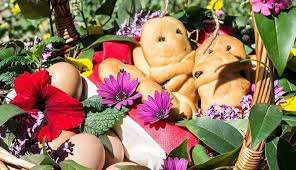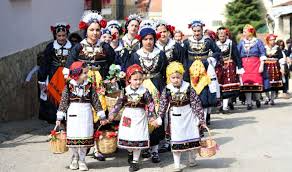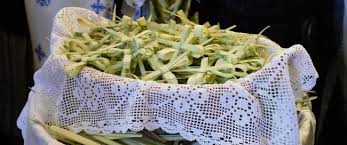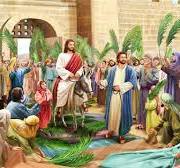The customs of Lazarus Saturday and Palm Sunday mark the end of Lent and the entrance into Holy Week. These are moments of collective memory, religious reverence, and social cohesion. Over the centuries many traditions and folk customs are associated with this feast among the people of Greece.
The Saturday of Lazarus is one of the most significant feast days in the Orthodox Church. It is a day of both life and death, marking the final great miracle of Christ before His resurrection. This miracle heralds His death and the authority He has over death when He cried out “Lazarus, come forth” after his friend had been dead four days.
 Lazarus Saturday celebrates the resurrection of Christ’s friend, Lazarus, four days after his death. In many regions of Greece, the faithful uphold the custom of baking the so-called “Lazarakia”—small human-shaped breads that symbolize Lazarus in his burial shroud. Crosses are carved into the Lazarakia, and cloves or small nails are placed where the eyes would be. Usually the children take part in the making and baking of the Lazarakia. In this way, the tradition is passed on from one generation to the next.
Lazarus Saturday celebrates the resurrection of Christ’s friend, Lazarus, four days after his death. In many regions of Greece, the faithful uphold the custom of baking the so-called “Lazarakia”—small human-shaped breads that symbolize Lazarus in his burial shroud. Crosses are carved into the Lazarakia, and cloves or small nails are placed where the eyes would be. Usually the children take part in the making and baking of the Lazarakia. In this way, the tradition is passed on from one generation to the next.
One of the most picturesque traditions of Lazarus Saturday is the singing of Lazarus carols, performed by children in villages and cities while holding flowers or decorated baskets. The songs recount the miracle of Lazarus’s Resurrection and serve as a prelude to Christ’s Resurrection. The lyrics vary from place to place but share common features such as a joyful tone and references to springtime nature.
 In Macedonia and Thrace, girls dress in traditional costumes, carry decorated wreaths, and go from house to house singing the Lazarus carols, exchanging wishes and receiving eggs or sweets. This tradition has roots in ancient fertility rites and today combines Christian faith with older folk elements. The Lazarines accompany their songs with circular dances, offering a unique spectacle that honours life, spring and the rebirth of nature. This is why spring is such an important season: everything is reborn.
In Macedonia and Thrace, girls dress in traditional costumes, carry decorated wreaths, and go from house to house singing the Lazarus carols, exchanging wishes and receiving eggs or sweets. This tradition has roots in ancient fertility rites and today combines Christian faith with older folk elements. The Lazarines accompany their songs with circular dances, offering a unique spectacle that honours life, spring and the rebirth of nature. This is why spring is such an important season: everything is reborn.
 Palm Sunday and the “Vagia” (Palm Branches)
Palm Sunday and the “Vagia” (Palm Branches)
Saturday of Lazarus is followed by Palm Sunday, commemorating Christ’s entry into Jerusalem, where the faithful welcomed Him with palm branches, shouting “Hosanna.” In churches, after the Divine Liturgy, priests bless and distribute palm branches to the faithful, which are usually woven into cross shapes. These palm crosses are taken from the church and placed behind the icons as a blessing for the home.
 There are many local customs associated with Palm Sunday. In Paros, girls weave wreaths from palm leaves and flowers and let them float on the sea while making wishes for health and happiness. Corfu celebrates with philharmonic bands and religious processions while in Zakynthos, the faithful throw palm leaves during the church service from the balconies of churches, creating a reverent yet festive atmosphere. Traditionally, fish is eaten on Palm Sunday, a prelude to the fasting during Holy Week, as no meat dishes are consumed until the Easter Sunday when lamb is the traditional dish throughout the country, cooked in various ways depending on the area. In the Peloponnease and other northern areas the lamb is put on the spit, while on many of the islands, the lamb is stuffed and baked in the oven.
There are many local customs associated with Palm Sunday. In Paros, girls weave wreaths from palm leaves and flowers and let them float on the sea while making wishes for health and happiness. Corfu celebrates with philharmonic bands and religious processions while in Zakynthos, the faithful throw palm leaves during the church service from the balconies of churches, creating a reverent yet festive atmosphere. Traditionally, fish is eaten on Palm Sunday, a prelude to the fasting during Holy Week, as no meat dishes are consumed until the Easter Sunday when lamb is the traditional dish throughout the country, cooked in various ways depending on the area. In the Peloponnease and other northern areas the lamb is put on the spit, while on many of the islands, the lamb is stuffed and baked in the oven.
A traditional Lazarus carol.
Tell us, Lazarus, what did you see
in Hades where you went?
I saw fears, I saw terrors,
I saw suffering and pain.
Give me a little water
to wash away the bitterness.
From my little heart I say it,
and I mourn and I weep.
May we come again next year,
and find you all in good health.
And may the head of this household
live for many years—
may he live a hundred years
and even surpass them.